GIMP 2.9.4 released
Report on the new features of the free graphic editor.
 We have just released the second dev-version of GIMP in the 2.9.x series, which is the result of six months of work. GIMP 2.9.4 is a powerful update:
We have just released the second dev-version of GIMP in the 2.9.x series, which is the result of six months of work. GIMP 2.9.4 is a powerful update:- updated interface;
- major improvements in color management;
- Ready to use tool MyPaint Brush ;
- symmetrical drawing;
- split preview for filters on GEGL.
In addition, dozens of bugs were fixed and numerous minor improvements were made in the graphical editor.
GIMP 2.9.4 is sufficiently reliable for use in production, but something else needs to be done. Therefore, the release of the stable version 2.10 will take some time. Please see the roadmap for a list of major changes that are being prepared in GIMP version 2.10.
')
Corrected interface and changes in usability
The new version features a few new Benoit Touchette themes in different shades of gray: Lighter, Light, Gray, Dark, Darker. The system design theme is preserved for those who prefer a completely uniform user interface among all desktop applications.
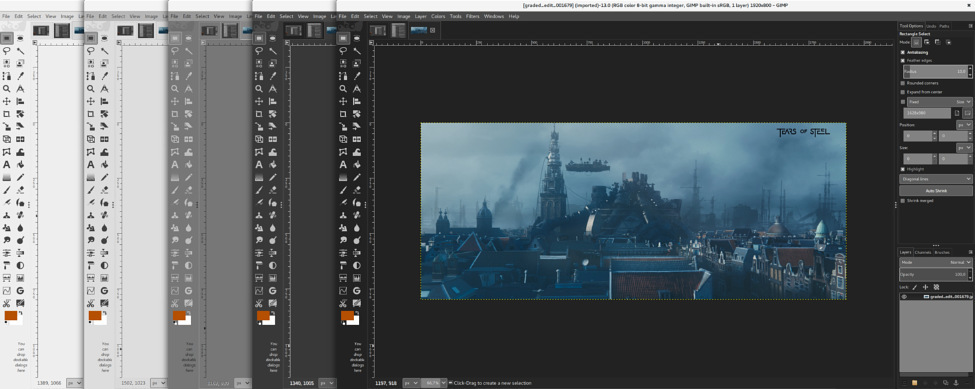
Note that in the roadmap, this function still has the status “in work”, because dark themes should be tuned in a bit more (especially the color of inactive menu items).
The new UI themes are accompanied by pictograms: Barbara Muraus and Jakub Steiner originally created them, but later Klaus Stadtler strongly added and brought to the final look. Existing icon themes from previous versions of GIMP are also saved, and users can freely switch between available themes and easily add their own icons.
The themes and icon sets are now separated from each other: you can mix your favorite themes and arbitrary sets of icons. Since most 2.8 themes do not work in 2.9.x, themes are not imported from GIMP <2.9. To create custom themes, you need to install those made specifically for GIMP 2.9 / 2.10.
All the works of Klaus Stadler with icons are made in a vector format (SVG), which in the future should be better displayed on HiDPI displays (also commonly known as “retina”). Vector icons are an experimental feature that is activated when using the configuration option
--enable-vector-icons during build build. Please note that at the moment this option does not mean HiDPI support.We cleared the Preferences menu a bit and placed the options in a more logical order. The Color Management dialogue has been redesigned in accordance with the internal and external changes in the relevant parts of the GIMP editor (see below), and the Snap Distance settings have moved to a separate Snapping page .
In addition, it is now possible to specify the size of the preview step for canceling the changes made in the Undo dialog via the Preferences dialog, which was previously possible only by manually editing the GIMP configuration file.
The splash screen when loading the editor is now accompanied by a loading indicator, which indicates that the GIMP is not frozen. Along with the background initialization of fontconfig (another new GIMP 2.9.4 function), this is due to a common problem when rebuilding the font cache (or creating such a cache initially) takes a long time, so it seems like the program is hanging while loading it. We understand that this is not a solution to the problem, but a small trick. For this solution, you need to dig into fontconfig . If you are interested in this topic, here is the corresponding ticket .
Improved color management
The implementation of color management is completely reworked in this version of GIMP. Instead of the plug-in module, this functionality is now built into the program kernel. Moreover, we have added a level of abstraction, which reduces the dependence of GIMP on LittleCMS . This means that in the future GIMP will use native programming interfaces on Windows and OS X and / or OCIO free color management system.
At the moment, this has allowed us to thoroughly clean out the code and make a clean implementation of color management for various parts of GIMP, such as previewing color samples and gradients, templates, various color widgets (including the drag and drop color widget), the “ Color Picker , preview layers and images, etc. The only color that remained unchanged remained in the Script-Fu and Python-Fu plug-ins. Moreover, GIMP will monitor which monitor is displayed on the widget (different ICC profiles work on different monitors) and make color correction accordingly.
Images in grayscale became equal again: since GIMP 2.9.4, color management also works for them.
Since the editor is now working in the sRGB color space (this will change in future versions of GIMP), we decided to set this in the user interface. So now in the editor, the option 'Color-manage this image' is set in two places: in the New Image dialog box ( New Image ) and in the
Image > Color Management submenu. ). This means that instead of using the integrated ICC profile (depending on the profile), the image will simply be perceived as sRGB. Keep in mind that we want to change the wording for this option to more explicitly indicate what it does.In addition, a separate submenu of
View > Color Management for color management operations has now appeared.The section “ Color Management ” in the settings has also been altered in accordance with the latest changes, and provided with more consistent descriptions of options.

Since color management affects the performance of the program (at least, now with LittleCMS), a new option has appeared that allows you to choose between better color rendering or better performance.
Among the more minor changes is the new command
Image > Color Management > Save Color Profile to File... ( Image > Color Management > Save Color Profile to File... ), which does exactly what is stated: saves the embedded ICC color profile to disk as a file. Keep in mind that ICC profiles can be burdened with intellectual property restrictions, so caution should be exercised.Gegl
GIMP now tracks all GEGL filters that you applied during your work session and allows you to reapply them from the
Filters > Recently Used submenu, just like the old GIMP plugins.The Posterize and Desaturate color tools are converted into regular GEGL filters, and both the Tile and Pagecurl filters are converted to use GEGL buffers. A rather popular “photographic” Highpass filter, which is commonly used to enhance detail, has been added to the
Filters > Enhance submenu.But much more noticeable is another new feature - split-preview of GEGL-filters. In the window divided into two halves, you can compare the image before and after applying the filter directly in the editor window, and move the border before / after around the screen, or change the position of “before” and after “places (click the mouse on the guide while holding Shift). Splitting the preview screen is possible vertically or horizontally (the orientation is changed (Ctrl + mouse click).
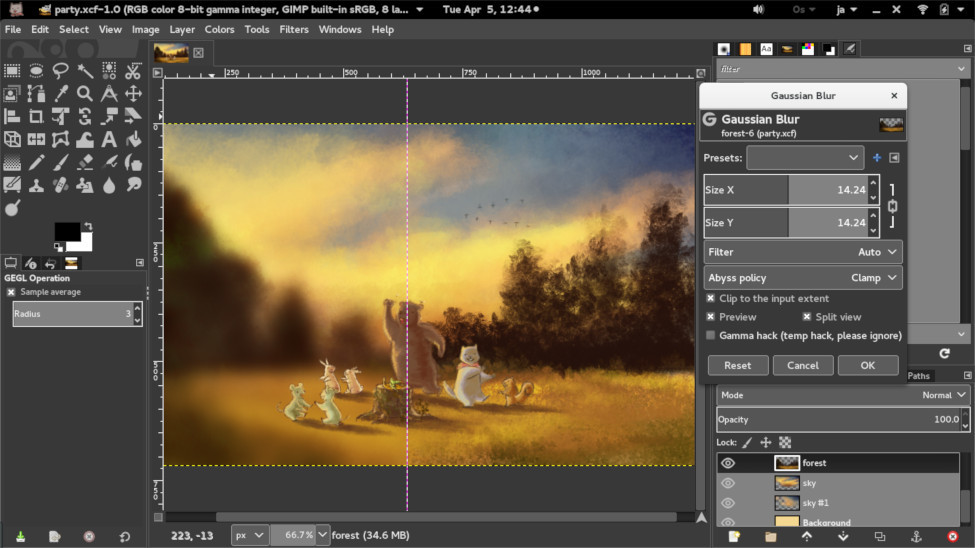
Darktable as a plugin for processing RAW photos
Linux-capable GIMP can use the free darktable application to pre-process raw photos in raw RAW format from Canon CR2 digital cameras, Nikon NEF and others. darktable is a terrific project in which developers constantly hang on the IRC channel and even send commits to GIMP (most recently they added the function of reading various metadata from EXR files).
Please note that the
file-darktable plugin is activated only if darktable is built with Lua support. Make sure your darktable build for Linux is properly built and supports all functions.It is still possible to use other plug-ins for working with RAW photos, such as
UFRaw . In case you have several such plug-ins installed on your system, we are going to add a selection option.Screenshots
The code for capturing screenshots has been significantly reworked. It is now distributed between the front-end and several backends, in different ways for Windows, OS X, Wayland and X.org (Linux and UNIX systems).
Although there are no visible changes from the side, the reorganization of the code will greatly facilitate further improvements, which will simplify the work with the editor in different operating systems.
Drawing
MyPaint Brush Tool
The new MyPaint tool is now activated by default. Daniel Sabo and Michael Natterer improved performance and made MyPaint brushes available through a familiar, pinable, conversational interface, with previews and labels.
Jehan Pagès collaborated with MyPaint developers and ported libmypaint to autotools . In particular, this allows you to make standard builds for all platforms, and now work is being done on the issue of default brushes in a separate independent package.
Symmetrical drawing
Another important new feature is the symmetric drawing mode, also developed by Jehan Pagees, with financial support from the GIMP community. This mode is activated through the new Symmetry Painting dialog and allows any tools to work in different symmetry modes (mirror, mandala, tile ...).
- "Mirror" allows you to draw in horizontal, vertical (axial) and / or central symmetry . Guides for symmetry can be placed anywhere on the canvas.
- Mandala is a rotating symmetry of any order.
- "Tiling" is a translational symmetry , which can be finite (with the maximum number of steps) or infinite. In the latter case, this is a great tool for creating patterns or seamless tiles, with instant rendering of the final result, right at the time of drawing.
Here is what you can draw in GIMP in 1 minute .

Tool parameters
Improved response to scrolling the mouse wheel. In combination with various modifiers, it now allows you to perform the following useful actions with a dedicated tool:
Alt +: increase / decrease transparency;Shift + Primary +: increase / decrease sides (aspect);Shift + Alt +: increase / decrease angle;Primary + Alt +: increase / decrease size;Shift + Primary + Alt +: increase / decrease spacing.
Note : The
Primary modifier is usually Ctrl or Cmd , depending on the platform.Allotment
For those cases where there are many small unselected areas in your selection, you can now use the
> command.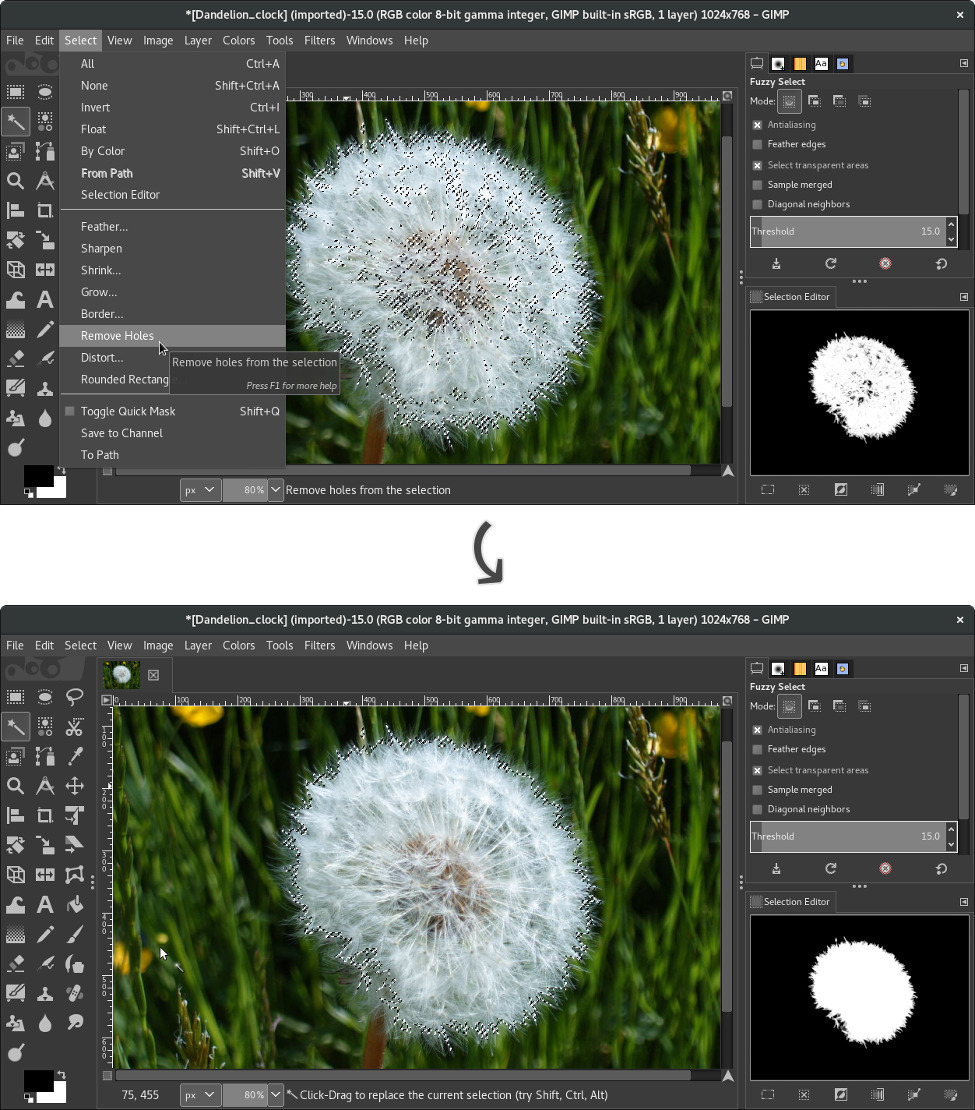
The
> dialog ( Select > Border ) now provides several options for the border style: hard, soft, or feathering (feathered). Border of the “ Feather ” type creates a selection that gradually changes from 1 to 0 as it is remote from the middle of the border. The soft border partially preserves the selection (anti-aliasing) along the selection boundaries.
Improved tools
In the tools " Magic Wand " ( Fuzzy Select ) and " Flat Fill " (Bucket Fill), a new function for selecting / filling the neighboring diagonal pixels.
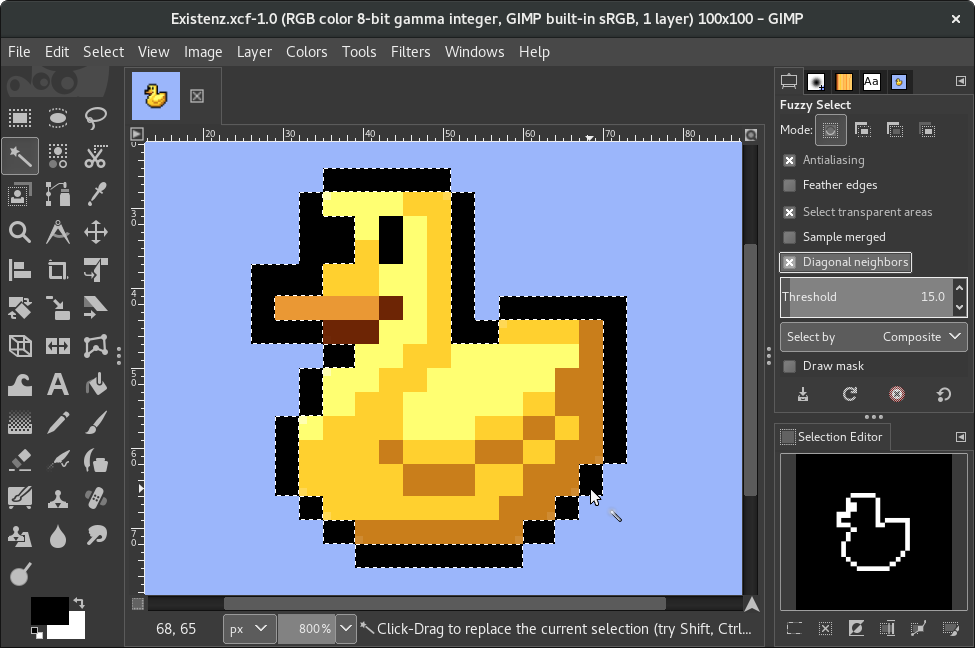
In the Blend gradient fill tool, the fill with the gradient style “Shape Burst” has returned, and the tool's control knobs can be placed on the canvas outside the image. In addition, the Gradient Fill tool is now equipped with a progress indicator, thanks to a new GEGL function, which is available in some GEGL operations, including
gegl:distance-transform .The Text Tool now fully supports advanced input methods for CJK and other non-Western languages. Minimal support has already been before, but the assembled text was displayed in a floating pop-up window, and not in its place, inside the text area, and without first showing the styles. The text is now displayed exactly as expected, depending on your platform and Input Method Engine. Also eliminated several bugs and causes of departure of the program in connection with the text input.
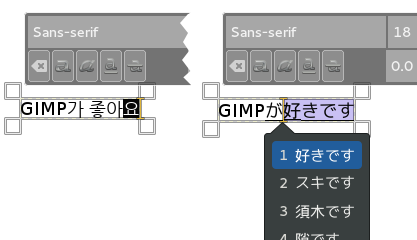
Command line batch processing
For simple processing using GIMP of numerous files from the command line, a new macro
with-files is available - many have been waiting for this feature.For example, if you want to invert colors on all PNG images in the current folder, and then save them as JPEG, you can run the following command for the macro from the command line:
gimp -i -b '(with-files "*.png" (gimp-invert layer) (gimp-file-save 1 image layer (string-append basename ".jpg") (string-append basename ".jpg") ) ) (gimp-quit 0)' Note : the name of the macro may change until exit 2.10.
Email Plugin
The
> … dialog ( File > Send by email… ) will open your standard email client and attach the current image from the editor to the letter, so you can share the results of your current work at the touch of a button. This is only possible on operating systems with xdg-email installed (most likely, only GNU / Linux, BSD).The original implementation using
sendmail also available. But since its work requires a properly configured sendmail, which is rarely found on desktop machines, you should specify the explicit option --with-sendmail during the build of the build to replace the xdg-email implementation.Logs for debugging
In the rare cases where GIMP crashes, we need to get as much information as possible to identify the cause of the failure. One of these sources of information is the original log, which is recorded upon failure. Now a Windows program can record such a log using Dr.MinGW's ExcHndl library , which should be available at the time of assembly. Logs are saved in
%APPDATA%\GIMP\2.9\CrashLog\ .What remains to be done for GIMP 2.10
Since the release of version 2.9.2, we basically fixed the bugs and completed the work started earlier. We no longer plan to add new core features in 2.10. If you want to help release version 2.10 as early as possible, a list of bug reports can be found in our bug tracker .
Some statistics on our amazing developers.
GIMP version 2.9.2 was released on November 27, 2015 . From then until release 2.9.4, 1348 commits were made, that is, an average of 5.9 commits per day , of which 894 (mostly) are associated with the software base, 241 - with pictograms, and 213 - updates for translations.
As usual, the GIMP development team is small, but extremely dedicated: more than a third of all commits were made by Michael Natterer (514), followed by Jehan Pages (192) and Klaus Stadler (187). These three provided 66% of all commits.
We had quite hard-working newbies:
- We were joined by Ell, who provided a significant contribution to the code base (32 commits), including the allocation of pixels adjacent to the diagonal, the Remove Holes command and many other fixes:
- Tobias Ellinghaus, the developer of the darktable project, sent 14 commits to integrate darktable and improve support for EXR and PNM.
Of course, we still have familiar people with 10+ commits: Alexander Prokudin, Daniel Szabo, Christian Rietveld, Massimo Valentini and Michael Henning.
To all of them, as well as dozens of other enthusiasts who participated in the development of GIMP 2.9.2, we want to say a big thank you.
Download
The source code is available on the download page . An installer for Windows will appear shortly. Build for Mac OS X is not ready yet.
Source: https://habr.com/ru/post/305710/
All Articles